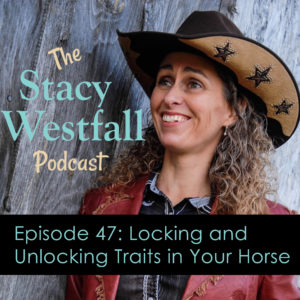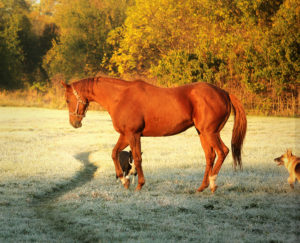Episode 47: Locking and Unlocking Traits in Your Horse

I know your horse is smart. Do you know that your horse is smart? I hope you do, because today I’m sharing something that will be incredibly useful to you if you think your horse is smart. If you’re not sure if your horse is smart, you can always go back and listen to episode 22 where I explain my views of going beyond prey versus predator.
In this episode, I’ll explain how to lock and unlock certain traits in your horse. Remember how the old school combination locks were difficult at first and then became easier over time? This concept is very similar, and you can use it to make a hot horse slow down or a lazy horse speed up or allow your horse to think at a higher level.
“By making one thing really hard to unlock and another thing really easy to unlock, it is effectively childproofing the horse.” Stacy Westfall Click To TweetShow Notes:
[02:00] Remember the old fashioned combination locks? Remember how they were hard to use at first, but then after a while, it was second nature. That is similar to the college-level concept that I will be presenting today.
[02:26] Early training will lead up to advanced training. It’s hard for me to answer the question of when I started writing bridleless because all of my prior training led up to that point.
[02:55] There are ways to make certain behaviors easier to access and ways to make certain behaviors harder to access.
[05:21] By making one thing really hard to unlock and another thing really easy to unlock, it effectively is childproofing the horse.

[08:23] Think about things that you want to make easier to access and things that you want to make harder to access with your horse. Make the safe things easy.
[08:52] With a cold horse, you might want to make the gas easier and the brakes less prominent. You might want to consider not treating all the cues exactly the same.
[10:36] Build your cue system and reverse what you want the horse to naturally do.
[11:03] A lazy horse might get three different go cues that are the only thing required.

[12:01] A hot horse might have to wait for all of those cues to be applied at the same time.
[13:51] A lot of horses appreciate moving to a higher level of thinking.
[14:07] Horses learn how to learn. That’s why it’s very important how you train them when they’re young. Intimidation will shut the horses desire to learn off.
[16:01] As the horse gets into college, he gets more freedom to discuss things, but it still needs to be done respectfully.

[17:37] Sometimes people are afraid to make the horse respectful, because they don’t want to intimidate them.
[19:41] If a horse hasn’t been trained through intimidation, it’s still capable of making decisions and asking questions.
[20:30] Newt was super educated, but he also liked doing simple things. He used grandma’s rules to his advantage.
[21:33] A high level trained horse is not impossible for other people to ride.
“If you have a really hot horse, you might want to put a padlock on the gas pedal and make the brakes really easy to access.” Stacy Westfall Click To Tweet
Links and Resources:
Equithrive Use the code STACY for 10% off and Free Shipping
Episode 22: Beyond Prey vs Predator: You’re Underestimating Your Horse
Episode 27: Horses Can ‘Learn how to Learn’
Stacy’s Video Diary: Jac-Episode 1-First Day-Part 1-Evaluating Jac
Starbucks Pony Espresso: Riding My Horse Thru the Drive Thru
Have you ever wondered what a live version of this podcast would be like?I’m hosting some live, online video calls that are like a live version of this podcast. I teach on a subject, answer questions and for those who are brave, I’ll turn your video on live too and you can join me for a conversation!
If you want to learn more about this you can visit https://stacywestfall.com/live/ for more information!
1 Comments
Leave a Comment
SUBSCRIBE TO THE PODCAST HERE:





YOURS FREE
WHY IS MY HORSE...?




Stacy, I am beginning to ride bridleless and am working on shoulder in on the circle. My gelding is lazy and sticky partially I believe to me doing Clinton Anderson disengaging hindquarters for so long! Yuck!!! I want to make sure I understand. So I want to create more impulsion so I need to make forward motion easy to unlock. To do that I need to isolate my cues. So first would I try and ride with more energy in my seat? What if I don’t notice a difference? Do I then wave with my legs? If I still don’t notice a difference then use the whip? I would need to follow through so then I would be using all three cues? How would I go about isolating each one?
Ok second question… this relates to the previous podcast. You stated that if a horse is lazy ride with intentional energy, ride for a shorter duration and get off of him when he is still energetic to keep motivation, exaggerate upward transitions….. ok this is where I’m confused. When my gelding is asked to go from a trot to a canter and he is balanced and forward i only ask for a few steps and then I have been melting down to release the pressure to motivate him. Is this not correct? I thought I should ask for fewer steps at the canter and when his energy is forward then I reward by melting down? I am working so so hard to learn!!!! I absolutely loved your podcast on engaging vs disengaging hq! All I knew was Clinton Anderson and I did soooooo many one rein stops! It has led to lack of forward motion and heaviness on the forehand. I appreciate your podcasts so much!! Thank you!